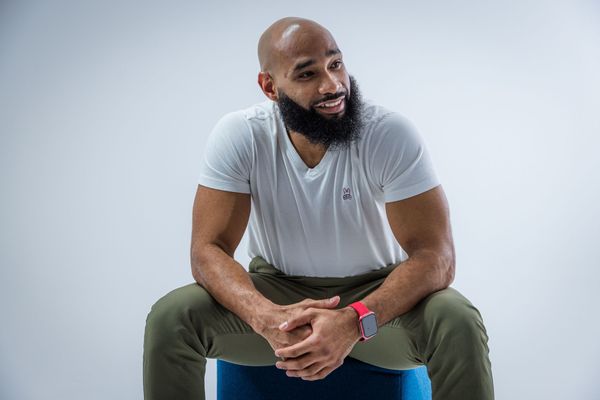This blog explains why many New Year’s health and fitness resolutions fall through, and how combining structured personal training with therapeutic massage creates a sustainable path. You’ll get guidance on setting realistic goals avoiding injury and leveraging recovery work so you stay on track all year long.

Why Most New Year’s Resolutions Don’t Work—And What You Can Do Differently
Carlos Salazar
This blog post explores the essential roles of personal training and massage therapy in achieving sustainable wellness goals. It provides insightful tips and expert advice on avoiding common pitfalls like burnout and injury while emphasizing the importance of recovery and body kindness. The article is written in an encouraging and professional tone, making it accessible and valuable for readers at all fitness and wellness levels.
As we ring in the New Year, many of us set ambitious resolutions to improve our health and fitness. However, by February, a significant number of these resolutions have already fallen by the wayside. Why is it so hard to stick to our goals? The issue often lies in how we approach these resolutions.
Many people set unrealistic goals and push themselves too hard and too fast. This leads to burnout and increases the risk of injury, which can derail your progress entirely.
Carlos Salazar, a personal trainer and massage therapist at Medical & Sports Massage, echoes this sentiment. "Being kind to your body while working towards your goals is important. Overdoing it can lead to physical injury, which is counterproductive."
Resetting Your Mindset for Successful Fitness Goals
Lack of a Clear Fitness Plan
One of the main reasons New Year's resolutions fail is the lack of a clear, actionable fitness plan. Setting vague or overly ambitious goals without a roadmap can overwhelm you and make you unsure of where to start. Not having a plan often means that you will push things out and not be held accountable for daily tasks that should be executed.
Overcoming Mindset Barriers to Achieving Health Goals
Unrealistic expectations and the "all-or-nothing" mentality can also hinder your progress. When you expect immediate results and don't see them, it's easy to become discouraged and give up. Remember, fitness is a marathon, not a sprint. Embrace the journey and celebrate each small step forward. Patience and persistence are key to achieving your long-term goals.
Avoiding Injuries by Respecting Physical Limitations
Starting intense workouts without proper preparation can lead to injury. It's essential to ease into your fitness routine and listen to your body's signals. Hopping aboard the last fitness craze rarely works. You will find better results when you work with a personal trainer. That way, you can receive customized workouts that work for your body.
Resetting Your Mindset for Successful Fitness Goals
Tailor your resolutions to your unique needs and limitations. SMART goals are Specific, Measurable, Achievable, Relevant, and Time-bound. This approach helps you create a clear path to success.
For example, if you're a student basketball player aiming to improve your game, a SMART goal might be: "I will increase my free throw accuracy by 10% within the next three months by practicing for 30 minutes, three times a week." This goal is specific (increase free throw accuracy), measurable (10% improvement), achievable (realistic given the time frame), relevant (important for your basketball skills), and time-bound (within three months).
On the other hand, if you're someone who has been relatively inactive and wants to start exercising, a SMART goal could be: "I will walk for 20 minutes three times a week for the next month, and gradually increase to 30 minutes by the end of the second month." This goal is specific (walking), measurable (20 minutes, three times a week), achievable (realistic for a beginner), relevant (important for improving overall health), and time-bound (within two months).
Prioritize Consistency Over Perfection
Focus on small, actionable steps rather than trying to be perfect. Consistency is key to long-term success.
Listen to Your Body
Recognize when to push and when to rest. Your body will give you signals, and paying attention to them is important.
The Role of a Personal Trainer and Massage Therapy in Achieve your Fitness Goals
Incorporating both personal training and massage therapy into your wellness routine can significantly enhance your journey toward a healthier, more active lifestyle. Personal trainers offer tailored plans and expert guidance to help you achieve your fitness goals safely and effectively, while massage therapy supports your recovery and overall well-being. Together, these practices create a holistic approach to wellness that addresses your health's physical and emotional aspects.
How Personal Training Can Enhance Your Wellness Journey
A personal trainer can create a personalized plan to avoid overtraining and reduce the risk of injury through proper technique. They also provide accountability and motivation, which can be invaluable in staying on track.
Engaging with a personal trainer means having a dedicated partner who understands your unique needs, limitations, and goals. Whether you're recovering from an injury, looking to improve your mobility, or aiming to build strength, a personal trainer ensures that you're progressing safely and effectively. Their expertise in proper technique and form helps prevent injuries, which is essential for long-term success.
In addition, personal trainers offer more than just physical guidance; they provide emotional support and motivation. They help you stay accountable, push when needed, and encourage you during challenging times. This holistic approach ensures that you work out and build a sustainable, healthy lifestyle.
The Role of Massage Therapy in Wellness Recovery and Overall Health
Massage therapy enhances recovery through techniques like sports massage and Graston therapy. It alleviates soreness and prevents long-term pain, supporting your overall wellness journey.
Massage therapy is not just a luxury; it's an essential component of your wellness routine. Techniques like sports massage and Graston therapy work wonders in enhancing recovery. They improve blood flow, reduce inflammation, and promote relaxation, all of which are vital for your body's healing process. Regular massage sessions can alleviate soreness, prevent long-term pain, and support your wellness. It's a proactive approach to maintaining a pain-free, active lifestyle.
By integrating personal training and massage therapy into your wellness routine, you'll set yourself up for success and ensure a sustainable, pain-free journey toward your goals. This comprehensive approach addresses the physical and emotional aspects of wellness, helping you achieve a balanced, healthy life.
Be Kind to Your Body
Being kind to your body is essential for achieving sustainable wellness gains. It's important to understand that progress takes time, and pushing yourself too hard and too fast can lead to burnout and injury. Start with small, manageable steps and gradually increase the intensity of your workouts. This approach helps prevent burnout and allows your body to adapt and grow stronger over time.
Recovery days are just as important as your workout days. During recovery, your muscles repair and rebuild, making you stronger and more resilient. Incorporating recovery days into your wellness routine ensures you're giving your body the time it needs to heal and prepare for the next challenge. Techniques like foam rolling, gentle stretching, and even light walks can enhance your recovery process.
Achieving a balance between strength, mobility, and relaxation is key to optimal wellness. Focus on exercises such as resistance training and yoga. Make time for relaxation techniques like deep breathing, meditation, or even a warm bath. This balanced approach ensures you address all aspects of your well-being, leading to a healthier, more sustainable lifestyle. Remember, wellness is a journey; being kind to your body will help you enjoy the process and achieve your goals more effectively.
Your Path To Success
Remember to focus on sustainable, healthy habits as you embark on your New Year’s resolutions. At LiveLifePainFree.com, we offer various services to support your fitness and recovery goals. Start your journey to a healthier, pain-free life today with expert trainers and therapists at Medical & Sports Massage.
How often should I get a massage while training?
The frequency of massages can vary depending on your training intensity and personal needs. Regular massages can support a long-term wellness plan by alleviating soreness and preventing pain. When training, you should try to include medical sports massages to target your specific needs.
What should I look for in a personal trainer?
When looking for a personal trainer, here are some key factors to consider:
Qualifications and Certifications: Look for a personal trainer who holds recognized certifications from organizations such as the National Academy of Sports Medicine (NASM), American Council on Exercise (ACE), or National Strength and Conditioning Association (NSCA). These certifications ensure that the trainer has the necessary knowledge and skills to provide safe and effective guidance.
Initial Consultation: During the initial consultation, a good personal trainer should assess your current fitness level, discuss your goals, and understand any health concerns or injuries. They should also explain their training philosophy and how they plan to help you achieve your objectives. This consultation is an opportunity for you to ask questions and ensure that you feel comfortable with the trainer.
Communication and Teaching Style: Effective communication is key. A good trainer should be able to explain exercises clearly and provide feedback in a way that you understand. They should also be approachable and open to your questions and concerns. Observing a session or asking for references can help you evaluate their teaching style.
Experience and Specialization: Experience matters, especially if you have specific goals or health conditions. A trainer with experience in your area of interest (e.g., weight loss, strength training, rehabilitation) can provide more tailored and effective guidance. Specializations in areas like corrective exercise, sports performance, or special populations can also be beneficial.
Personality and Compatibility: Personality and compatibility are important. You should feel comfortable and motivated by your trainer. A positive and supportive relationship can enhance your training experience and help you stay committed to your goals. Look for someone who is encouraging, patient, and aligns with your personality.
Safety and Injury Prevention: A good personal trainer prioritizes safety and injury prevention. They should teach proper exercise form and technique, gradually increase the intensity of workouts, and modify exercises based on your abilities and any limitations. They should also be knowledgeable about first aid and emergency procedures.
Progress Tracking and Accountability: A personal trainer should regularly track your progress and adjust your training plan as needed. They should set measurable goals and provide feedback on your improvements. Accountability is also important; a good trainer will help keep you motivated and on track with your fitness journey.
By considering these factors, you can find a personal trainer who can help you achieve your fitness goals safely and effectively.
Can I combine personal training with recovery services?
Absolutely! At Medical & Sports Massage, we offer packages that combine personal training with recovery services to provide a comprehensive approach to your wellness journey.
How does overtraining lead to injury?
Overtraining leads to injury through several interconnected ways:
Muscle Fatigue and Breakdown: Overtraining causes chronic fatigue and muscle breakdown. Without adequate recovery, micro-tears in muscle fibers can develop into more serious injuries like strains and tears.
Compromised Form and Technique: Fatigue from overtraining often leads to poor form and technique during workouts. This increases the risk of injuries such as sprains, strains, and even fractures.
Reduced Immune Function: Overtraining can weaken your immune system, making you more susceptible to illnesses and infections. This reduced immune function slows down the healing process of minor injuries, turning them into more significant issues.
Hormonal Imbalances: Intense, prolonged training can lead to hormonal imbalances, particularly affecting cortisol levels. Elevated cortisol can suppress the immune system, reduce muscle protein synthesis, and increase muscle breakdown, making your body more prone to injuries.
Mental and Emotional Stress: Overtraining can cause chronic fatigue, decreased motivation, and increased irritability. This mental stress can lead to a lack of focus during workouts, further increasing the risk of injury.
By understanding these risks, you can take proactive steps to prevent overtraining and reduce the risk of injury, ensuring a healthier and more sustainable fitness journey.
